The Role of HR and Financial Management: A Detailed Report
VerifiedAdded on 2023/01/12
|9
|2590
|49
Report
AI Summary
This report provides an overview of the roles of Human Resource (HR) and Financial Management within an organization. It begins by defining a portfolio and then delves into the significance of HR, covering aspects such as staffing, policy-making, compensation, training, and motivation, including Maslow's Hierarchy of Needs. The report then explores financial management, emphasizing its role in financial decision-making, capital management, cash flow, profit distribution, financial planning, allocation of funds, financial reporting, and risk management. The report highlights how both HR and financial management are crucial for the smooth operation, efficiency, and long-term success of a business. The report uses case studies and examples to illustrate key concepts. The report emphasizes the importance of HR in hiring, training, and motivating employees, and the role of financial management in making key financial decisions, managing capital, and ensuring adequate cash flow.

Coursework 1- Portfolio
Paraphrase This Document
Need a fresh take? Get an instant paraphrase of this document with our AI Paraphraser
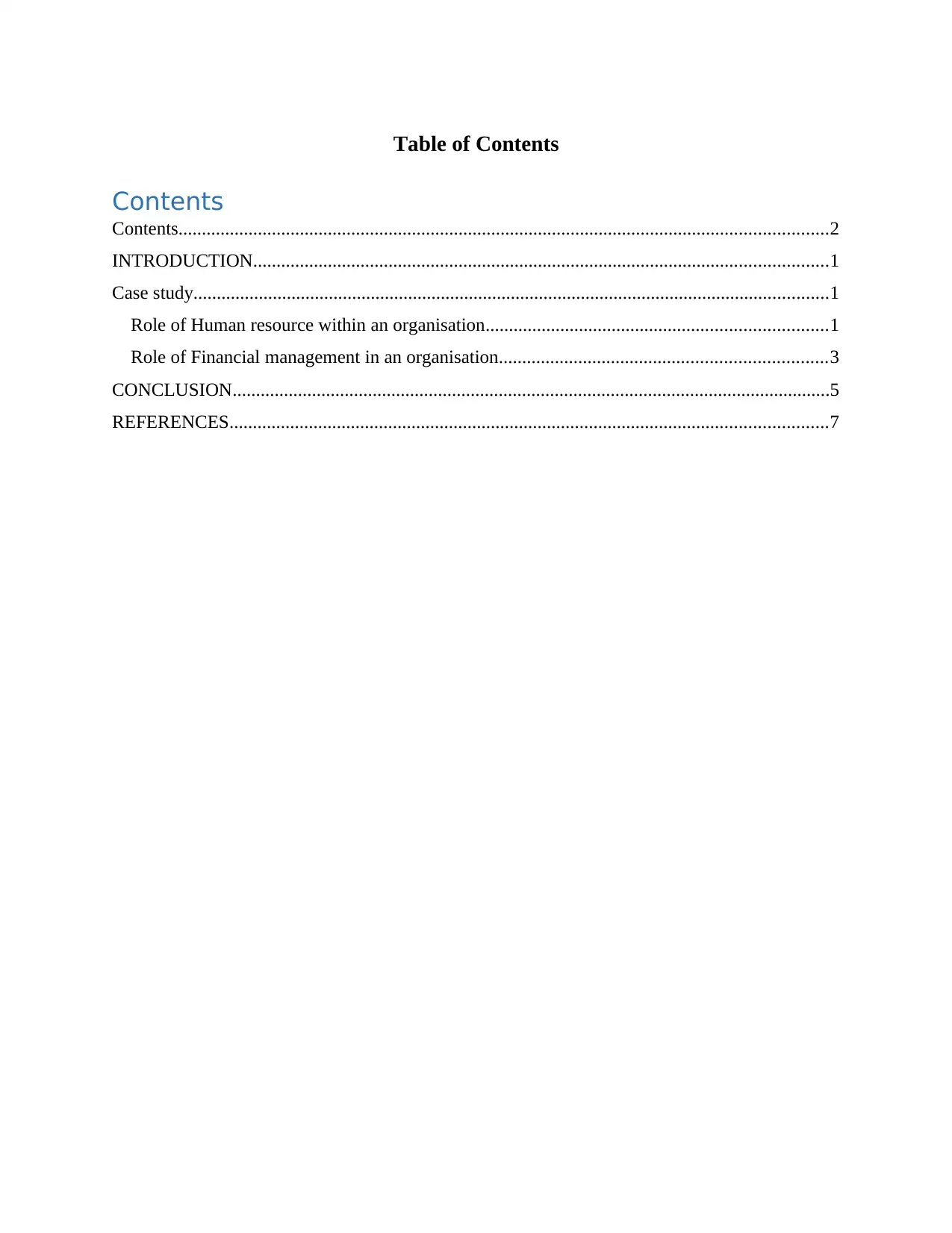
Table of Contents
Contents
Contents...........................................................................................................................................2
INTRODUCTION...........................................................................................................................1
Case study........................................................................................................................................1
Role of Human resource within an organisation.........................................................................1
Role of Financial management in an organisation......................................................................3
CONCLUSION................................................................................................................................5
REFERENCES................................................................................................................................7
Contents
Contents...........................................................................................................................................2
INTRODUCTION...........................................................................................................................1
Case study........................................................................................................................................1
Role of Human resource within an organisation.........................................................................1
Role of Financial management in an organisation......................................................................3
CONCLUSION................................................................................................................................5
REFERENCES................................................................................................................................7
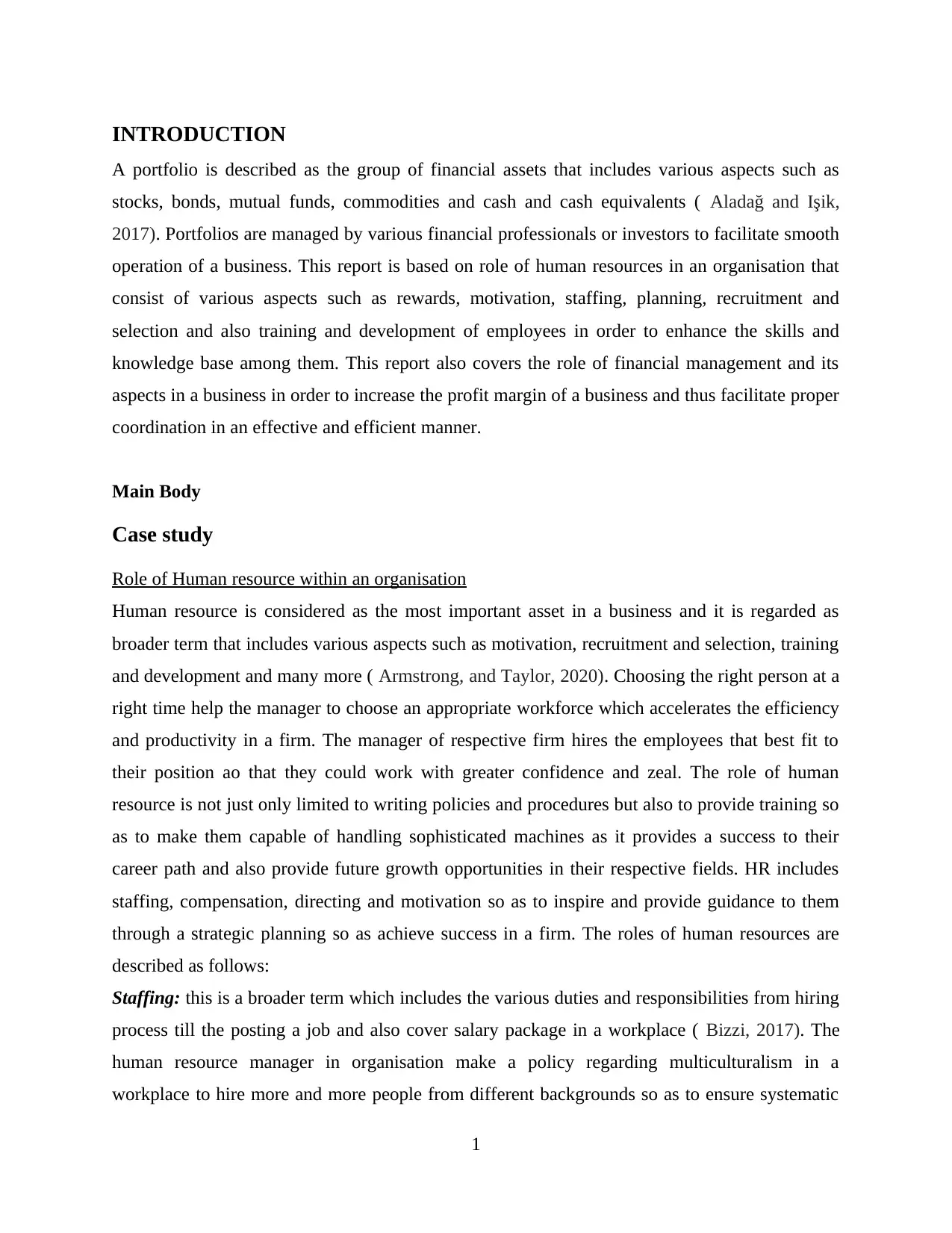
INTRODUCTION
A portfolio is described as the group of financial assets that includes various aspects such as
stocks, bonds, mutual funds, commodities and cash and cash equivalents ( Aladağ and Işik,
2017). Portfolios are managed by various financial professionals or investors to facilitate smooth
operation of a business. This report is based on role of human resources in an organisation that
consist of various aspects such as rewards, motivation, staffing, planning, recruitment and
selection and also training and development of employees in order to enhance the skills and
knowledge base among them. This report also covers the role of financial management and its
aspects in a business in order to increase the profit margin of a business and thus facilitate proper
coordination in an effective and efficient manner.
Main Body
Case study
Role of Human resource within an organisation
Human resource is considered as the most important asset in a business and it is regarded as
broader term that includes various aspects such as motivation, recruitment and selection, training
and development and many more ( Armstrong, and Taylor, 2020). Choosing the right person at a
right time help the manager to choose an appropriate workforce which accelerates the efficiency
and productivity in a firm. The manager of respective firm hires the employees that best fit to
their position ao that they could work with greater confidence and zeal. The role of human
resource is not just only limited to writing policies and procedures but also to provide training so
as to make them capable of handling sophisticated machines as it provides a success to their
career path and also provide future growth opportunities in their respective fields. HR includes
staffing, compensation, directing and motivation so as to inspire and provide guidance to them
through a strategic planning so as achieve success in a firm. The roles of human resources are
described as follows:
Staffing: this is a broader term which includes the various duties and responsibilities from hiring
process till the posting a job and also cover salary package in a workplace ( Bizzi, 2017). The
human resource manager in organisation make a policy regarding multiculturalism in a
workplace to hire more and more people from different backgrounds so as to ensure systematic
1
A portfolio is described as the group of financial assets that includes various aspects such as
stocks, bonds, mutual funds, commodities and cash and cash equivalents ( Aladağ and Işik,
2017). Portfolios are managed by various financial professionals or investors to facilitate smooth
operation of a business. This report is based on role of human resources in an organisation that
consist of various aspects such as rewards, motivation, staffing, planning, recruitment and
selection and also training and development of employees in order to enhance the skills and
knowledge base among them. This report also covers the role of financial management and its
aspects in a business in order to increase the profit margin of a business and thus facilitate proper
coordination in an effective and efficient manner.
Main Body
Case study
Role of Human resource within an organisation
Human resource is considered as the most important asset in a business and it is regarded as
broader term that includes various aspects such as motivation, recruitment and selection, training
and development and many more ( Armstrong, and Taylor, 2020). Choosing the right person at a
right time help the manager to choose an appropriate workforce which accelerates the efficiency
and productivity in a firm. The manager of respective firm hires the employees that best fit to
their position ao that they could work with greater confidence and zeal. The role of human
resource is not just only limited to writing policies and procedures but also to provide training so
as to make them capable of handling sophisticated machines as it provides a success to their
career path and also provide future growth opportunities in their respective fields. HR includes
staffing, compensation, directing and motivation so as to inspire and provide guidance to them
through a strategic planning so as achieve success in a firm. The roles of human resources are
described as follows:
Staffing: this is a broader term which includes the various duties and responsibilities from hiring
process till the posting a job and also cover salary package in a workplace ( Bizzi, 2017). The
human resource manager in organisation make a policy regarding multiculturalism in a
workplace to hire more and more people from different backgrounds so as to ensure systematic
1
⊘ This is a preview!⊘
Do you want full access?
Subscribe today to unlock all pages.

Trusted by 1+ million students worldwide
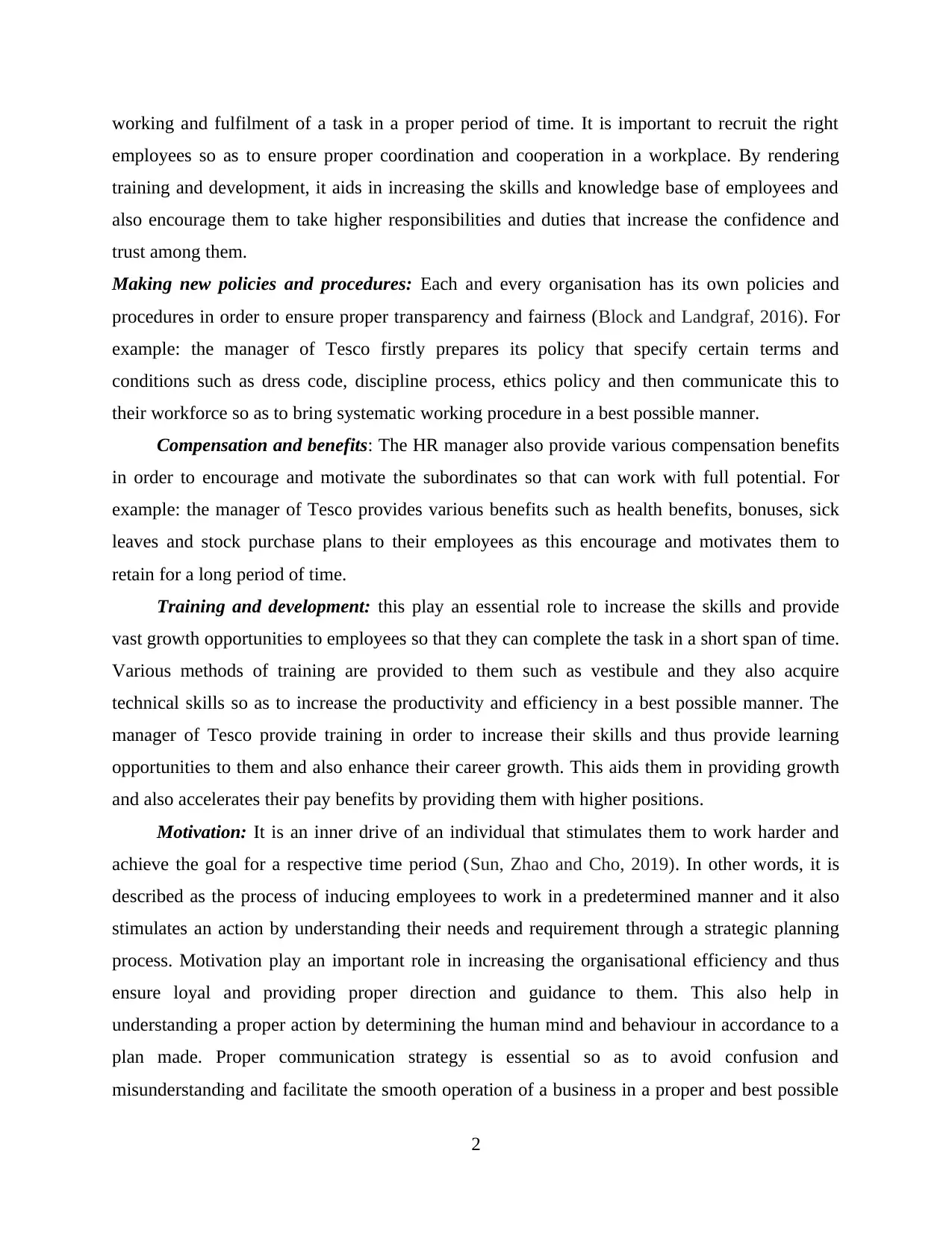
working and fulfilment of a task in a proper period of time. It is important to recruit the right
employees so as to ensure proper coordination and cooperation in a workplace. By rendering
training and development, it aids in increasing the skills and knowledge base of employees and
also encourage them to take higher responsibilities and duties that increase the confidence and
trust among them.
Making new policies and procedures: Each and every organisation has its own policies and
procedures in order to ensure proper transparency and fairness (Block and Landgraf, 2016). For
example: the manager of Tesco firstly prepares its policy that specify certain terms and
conditions such as dress code, discipline process, ethics policy and then communicate this to
their workforce so as to bring systematic working procedure in a best possible manner.
Compensation and benefits: The HR manager also provide various compensation benefits
in order to encourage and motivate the subordinates so that can work with full potential. For
example: the manager of Tesco provides various benefits such as health benefits, bonuses, sick
leaves and stock purchase plans to their employees as this encourage and motivates them to
retain for a long period of time.
Training and development: this play an essential role to increase the skills and provide
vast growth opportunities to employees so that they can complete the task in a short span of time.
Various methods of training are provided to them such as vestibule and they also acquire
technical skills so as to increase the productivity and efficiency in a best possible manner. The
manager of Tesco provide training in order to increase their skills and thus provide learning
opportunities to them and also enhance their career growth. This aids them in providing growth
and also accelerates their pay benefits by providing them with higher positions.
Motivation: It is an inner drive of an individual that stimulates them to work harder and
achieve the goal for a respective time period (Sun, Zhao and Cho, 2019). In other words, it is
described as the process of inducing employees to work in a predetermined manner and it also
stimulates an action by understanding their needs and requirement through a strategic planning
process. Motivation play an important role in increasing the organisational efficiency and thus
ensure loyal and providing proper direction and guidance to them. This also help in
understanding a proper action by determining the human mind and behaviour in accordance to a
plan made. Proper communication strategy is essential so as to avoid confusion and
misunderstanding and facilitate the smooth operation of a business in a proper and best possible
2
employees so as to ensure proper coordination and cooperation in a workplace. By rendering
training and development, it aids in increasing the skills and knowledge base of employees and
also encourage them to take higher responsibilities and duties that increase the confidence and
trust among them.
Making new policies and procedures: Each and every organisation has its own policies and
procedures in order to ensure proper transparency and fairness (Block and Landgraf, 2016). For
example: the manager of Tesco firstly prepares its policy that specify certain terms and
conditions such as dress code, discipline process, ethics policy and then communicate this to
their workforce so as to bring systematic working procedure in a best possible manner.
Compensation and benefits: The HR manager also provide various compensation benefits
in order to encourage and motivate the subordinates so that can work with full potential. For
example: the manager of Tesco provides various benefits such as health benefits, bonuses, sick
leaves and stock purchase plans to their employees as this encourage and motivates them to
retain for a long period of time.
Training and development: this play an essential role to increase the skills and provide
vast growth opportunities to employees so that they can complete the task in a short span of time.
Various methods of training are provided to them such as vestibule and they also acquire
technical skills so as to increase the productivity and efficiency in a best possible manner. The
manager of Tesco provide training in order to increase their skills and thus provide learning
opportunities to them and also enhance their career growth. This aids them in providing growth
and also accelerates their pay benefits by providing them with higher positions.
Motivation: It is an inner drive of an individual that stimulates them to work harder and
achieve the goal for a respective time period (Sun, Zhao and Cho, 2019). In other words, it is
described as the process of inducing employees to work in a predetermined manner and it also
stimulates an action by understanding their needs and requirement through a strategic planning
process. Motivation play an important role in increasing the organisational efficiency and thus
ensure loyal and providing proper direction and guidance to them. This also help in
understanding a proper action by determining the human mind and behaviour in accordance to a
plan made. Proper communication strategy is essential so as to avoid confusion and
misunderstanding and facilitate the smooth operation of a business in a proper and best possible
2
Paraphrase This Document
Need a fresh take? Get an instant paraphrase of this document with our AI Paraphraser
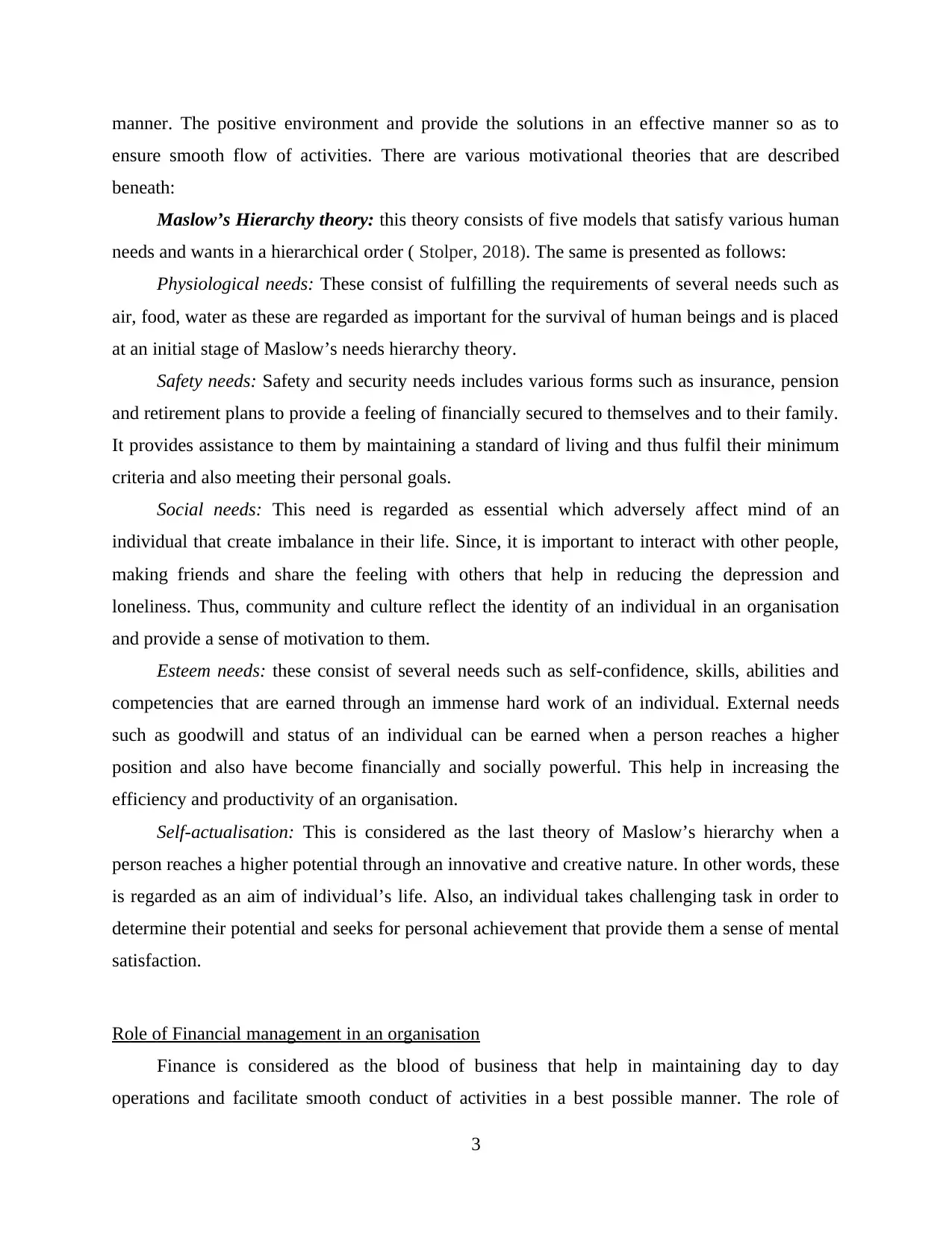
manner. The positive environment and provide the solutions in an effective manner so as to
ensure smooth flow of activities. There are various motivational theories that are described
beneath:
Maslow’s Hierarchy theory: this theory consists of five models that satisfy various human
needs and wants in a hierarchical order ( Stolper, 2018). The same is presented as follows:
Physiological needs: These consist of fulfilling the requirements of several needs such as
air, food, water as these are regarded as important for the survival of human beings and is placed
at an initial stage of Maslow’s needs hierarchy theory.
Safety needs: Safety and security needs includes various forms such as insurance, pension
and retirement plans to provide a feeling of financially secured to themselves and to their family.
It provides assistance to them by maintaining a standard of living and thus fulfil their minimum
criteria and also meeting their personal goals.
Social needs: This need is regarded as essential which adversely affect mind of an
individual that create imbalance in their life. Since, it is important to interact with other people,
making friends and share the feeling with others that help in reducing the depression and
loneliness. Thus, community and culture reflect the identity of an individual in an organisation
and provide a sense of motivation to them.
Esteem needs: these consist of several needs such as self-confidence, skills, abilities and
competencies that are earned through an immense hard work of an individual. External needs
such as goodwill and status of an individual can be earned when a person reaches a higher
position and also have become financially and socially powerful. This help in increasing the
efficiency and productivity of an organisation.
Self-actualisation: This is considered as the last theory of Maslow’s hierarchy when a
person reaches a higher potential through an innovative and creative nature. In other words, these
is regarded as an aim of individual’s life. Also, an individual takes challenging task in order to
determine their potential and seeks for personal achievement that provide them a sense of mental
satisfaction.
Role of Financial management in an organisation
Finance is considered as the blood of business that help in maintaining day to day
operations and facilitate smooth conduct of activities in a best possible manner. The role of
3
ensure smooth flow of activities. There are various motivational theories that are described
beneath:
Maslow’s Hierarchy theory: this theory consists of five models that satisfy various human
needs and wants in a hierarchical order ( Stolper, 2018). The same is presented as follows:
Physiological needs: These consist of fulfilling the requirements of several needs such as
air, food, water as these are regarded as important for the survival of human beings and is placed
at an initial stage of Maslow’s needs hierarchy theory.
Safety needs: Safety and security needs includes various forms such as insurance, pension
and retirement plans to provide a feeling of financially secured to themselves and to their family.
It provides assistance to them by maintaining a standard of living and thus fulfil their minimum
criteria and also meeting their personal goals.
Social needs: This need is regarded as essential which adversely affect mind of an
individual that create imbalance in their life. Since, it is important to interact with other people,
making friends and share the feeling with others that help in reducing the depression and
loneliness. Thus, community and culture reflect the identity of an individual in an organisation
and provide a sense of motivation to them.
Esteem needs: these consist of several needs such as self-confidence, skills, abilities and
competencies that are earned through an immense hard work of an individual. External needs
such as goodwill and status of an individual can be earned when a person reaches a higher
position and also have become financially and socially powerful. This help in increasing the
efficiency and productivity of an organisation.
Self-actualisation: This is considered as the last theory of Maslow’s hierarchy when a
person reaches a higher potential through an innovative and creative nature. In other words, these
is regarded as an aim of individual’s life. Also, an individual takes challenging task in order to
determine their potential and seeks for personal achievement that provide them a sense of mental
satisfaction.
Role of Financial management in an organisation
Finance is considered as the blood of business that help in maintaining day to day
operations and facilitate smooth conduct of activities in a best possible manner. The role of
3
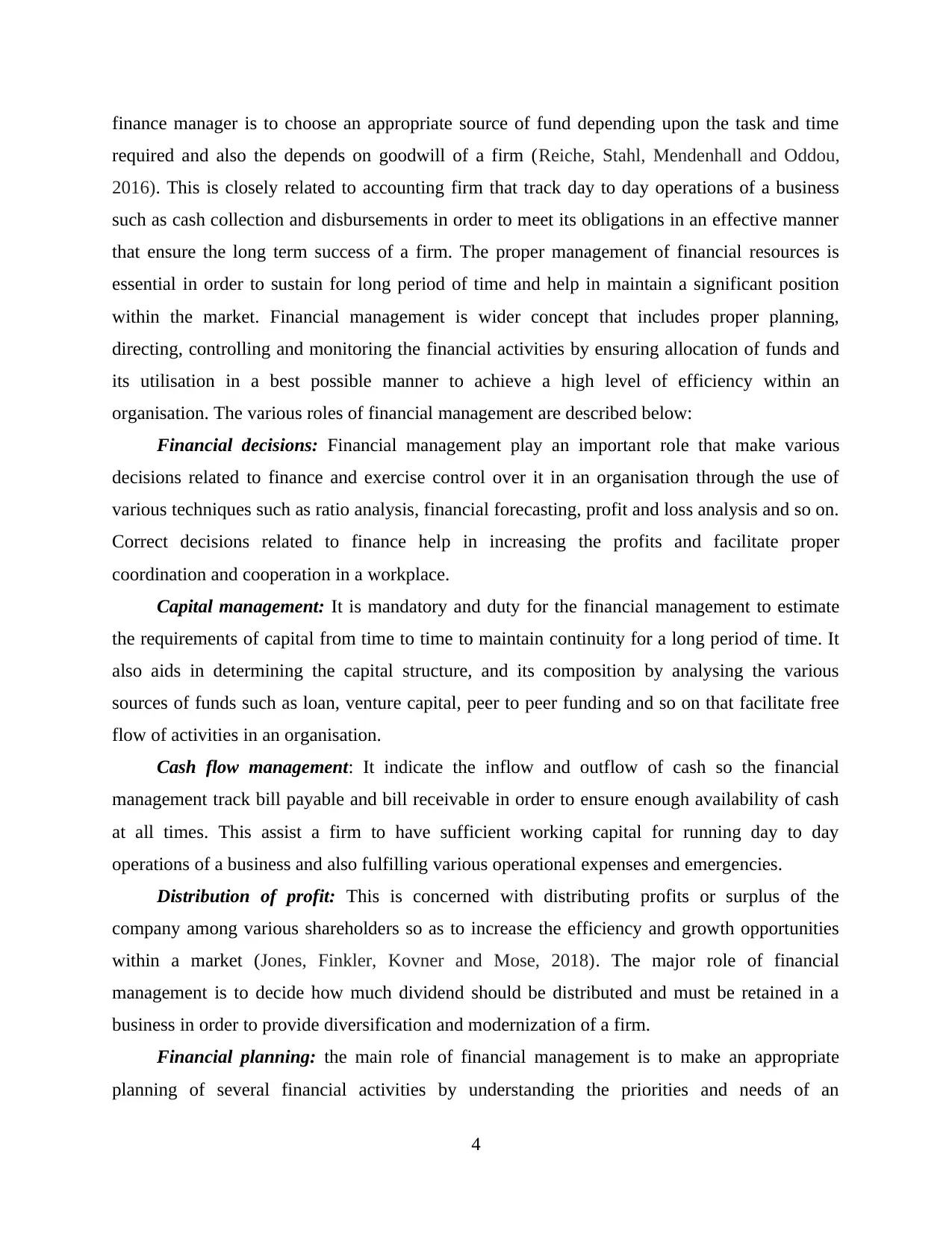
finance manager is to choose an appropriate source of fund depending upon the task and time
required and also the depends on goodwill of a firm (Reiche, Stahl, Mendenhall and Oddou,
2016). This is closely related to accounting firm that track day to day operations of a business
such as cash collection and disbursements in order to meet its obligations in an effective manner
that ensure the long term success of a firm. The proper management of financial resources is
essential in order to sustain for long period of time and help in maintain a significant position
within the market. Financial management is wider concept that includes proper planning,
directing, controlling and monitoring the financial activities by ensuring allocation of funds and
its utilisation in a best possible manner to achieve a high level of efficiency within an
organisation. The various roles of financial management are described below:
Financial decisions: Financial management play an important role that make various
decisions related to finance and exercise control over it in an organisation through the use of
various techniques such as ratio analysis, financial forecasting, profit and loss analysis and so on.
Correct decisions related to finance help in increasing the profits and facilitate proper
coordination and cooperation in a workplace.
Capital management: It is mandatory and duty for the financial management to estimate
the requirements of capital from time to time to maintain continuity for a long period of time. It
also aids in determining the capital structure, and its composition by analysing the various
sources of funds such as loan, venture capital, peer to peer funding and so on that facilitate free
flow of activities in an organisation.
Cash flow management: It indicate the inflow and outflow of cash so the financial
management track bill payable and bill receivable in order to ensure enough availability of cash
at all times. This assist a firm to have sufficient working capital for running day to day
operations of a business and also fulfilling various operational expenses and emergencies.
Distribution of profit: This is concerned with distributing profits or surplus of the
company among various shareholders so as to increase the efficiency and growth opportunities
within a market (Jones, Finkler, Kovner and Mose, 2018). The major role of financial
management is to decide how much dividend should be distributed and must be retained in a
business in order to provide diversification and modernization of a firm.
Financial planning: the main role of financial management is to make an appropriate
planning of several financial activities by understanding the priorities and needs of an
4
required and also the depends on goodwill of a firm (Reiche, Stahl, Mendenhall and Oddou,
2016). This is closely related to accounting firm that track day to day operations of a business
such as cash collection and disbursements in order to meet its obligations in an effective manner
that ensure the long term success of a firm. The proper management of financial resources is
essential in order to sustain for long period of time and help in maintain a significant position
within the market. Financial management is wider concept that includes proper planning,
directing, controlling and monitoring the financial activities by ensuring allocation of funds and
its utilisation in a best possible manner to achieve a high level of efficiency within an
organisation. The various roles of financial management are described below:
Financial decisions: Financial management play an important role that make various
decisions related to finance and exercise control over it in an organisation through the use of
various techniques such as ratio analysis, financial forecasting, profit and loss analysis and so on.
Correct decisions related to finance help in increasing the profits and facilitate proper
coordination and cooperation in a workplace.
Capital management: It is mandatory and duty for the financial management to estimate
the requirements of capital from time to time to maintain continuity for a long period of time. It
also aids in determining the capital structure, and its composition by analysing the various
sources of funds such as loan, venture capital, peer to peer funding and so on that facilitate free
flow of activities in an organisation.
Cash flow management: It indicate the inflow and outflow of cash so the financial
management track bill payable and bill receivable in order to ensure enough availability of cash
at all times. This assist a firm to have sufficient working capital for running day to day
operations of a business and also fulfilling various operational expenses and emergencies.
Distribution of profit: This is concerned with distributing profits or surplus of the
company among various shareholders so as to increase the efficiency and growth opportunities
within a market (Jones, Finkler, Kovner and Mose, 2018). The major role of financial
management is to decide how much dividend should be distributed and must be retained in a
business in order to provide diversification and modernization of a firm.
Financial planning: the main role of financial management is to make an appropriate
planning of several financial activities by understanding the priorities and needs of an
4
⊘ This is a preview!⊘
Do you want full access?
Subscribe today to unlock all pages.

Trusted by 1+ million students worldwide
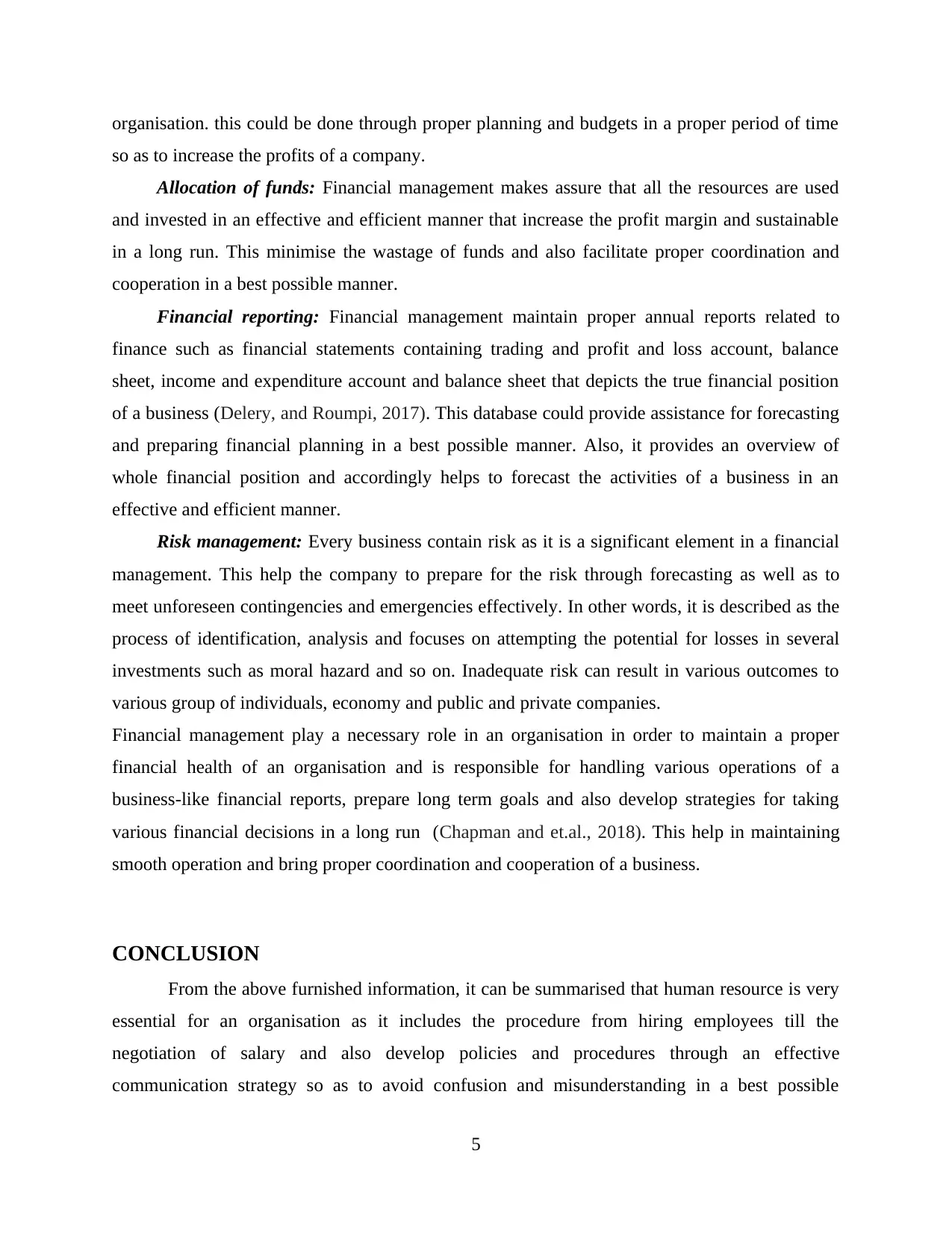
organisation. this could be done through proper planning and budgets in a proper period of time
so as to increase the profits of a company.
Allocation of funds: Financial management makes assure that all the resources are used
and invested in an effective and efficient manner that increase the profit margin and sustainable
in a long run. This minimise the wastage of funds and also facilitate proper coordination and
cooperation in a best possible manner.
Financial reporting: Financial management maintain proper annual reports related to
finance such as financial statements containing trading and profit and loss account, balance
sheet, income and expenditure account and balance sheet that depicts the true financial position
of a business (Delery, and Roumpi, 2017). This database could provide assistance for forecasting
and preparing financial planning in a best possible manner. Also, it provides an overview of
whole financial position and accordingly helps to forecast the activities of a business in an
effective and efficient manner.
Risk management: Every business contain risk as it is a significant element in a financial
management. This help the company to prepare for the risk through forecasting as well as to
meet unforeseen contingencies and emergencies effectively. In other words, it is described as the
process of identification, analysis and focuses on attempting the potential for losses in several
investments such as moral hazard and so on. Inadequate risk can result in various outcomes to
various group of individuals, economy and public and private companies.
Financial management play a necessary role in an organisation in order to maintain a proper
financial health of an organisation and is responsible for handling various operations of a
business-like financial reports, prepare long term goals and also develop strategies for taking
various financial decisions in a long run (Chapman and et.al., 2018). This help in maintaining
smooth operation and bring proper coordination and cooperation of a business.
CONCLUSION
From the above furnished information, it can be summarised that human resource is very
essential for an organisation as it includes the procedure from hiring employees till the
negotiation of salary and also develop policies and procedures through an effective
communication strategy so as to avoid confusion and misunderstanding in a best possible
5
so as to increase the profits of a company.
Allocation of funds: Financial management makes assure that all the resources are used
and invested in an effective and efficient manner that increase the profit margin and sustainable
in a long run. This minimise the wastage of funds and also facilitate proper coordination and
cooperation in a best possible manner.
Financial reporting: Financial management maintain proper annual reports related to
finance such as financial statements containing trading and profit and loss account, balance
sheet, income and expenditure account and balance sheet that depicts the true financial position
of a business (Delery, and Roumpi, 2017). This database could provide assistance for forecasting
and preparing financial planning in a best possible manner. Also, it provides an overview of
whole financial position and accordingly helps to forecast the activities of a business in an
effective and efficient manner.
Risk management: Every business contain risk as it is a significant element in a financial
management. This help the company to prepare for the risk through forecasting as well as to
meet unforeseen contingencies and emergencies effectively. In other words, it is described as the
process of identification, analysis and focuses on attempting the potential for losses in several
investments such as moral hazard and so on. Inadequate risk can result in various outcomes to
various group of individuals, economy and public and private companies.
Financial management play a necessary role in an organisation in order to maintain a proper
financial health of an organisation and is responsible for handling various operations of a
business-like financial reports, prepare long term goals and also develop strategies for taking
various financial decisions in a long run (Chapman and et.al., 2018). This help in maintaining
smooth operation and bring proper coordination and cooperation of a business.
CONCLUSION
From the above furnished information, it can be summarised that human resource is very
essential for an organisation as it includes the procedure from hiring employees till the
negotiation of salary and also develop policies and procedures through an effective
communication strategy so as to avoid confusion and misunderstanding in a best possible
5
Paraphrase This Document
Need a fresh take? Get an instant paraphrase of this document with our AI Paraphraser

manner. It has been analysed that finance management play a necessary role to maintain an
effective operation of a business also aids in meeting the obligations of various investors by
taking decisions related to capital budgeting and also ensure optimum utilisation of funds.
6
effective operation of a business also aids in meeting the obligations of various investors by
taking decisions related to capital budgeting and also ensure optimum utilisation of funds.
6
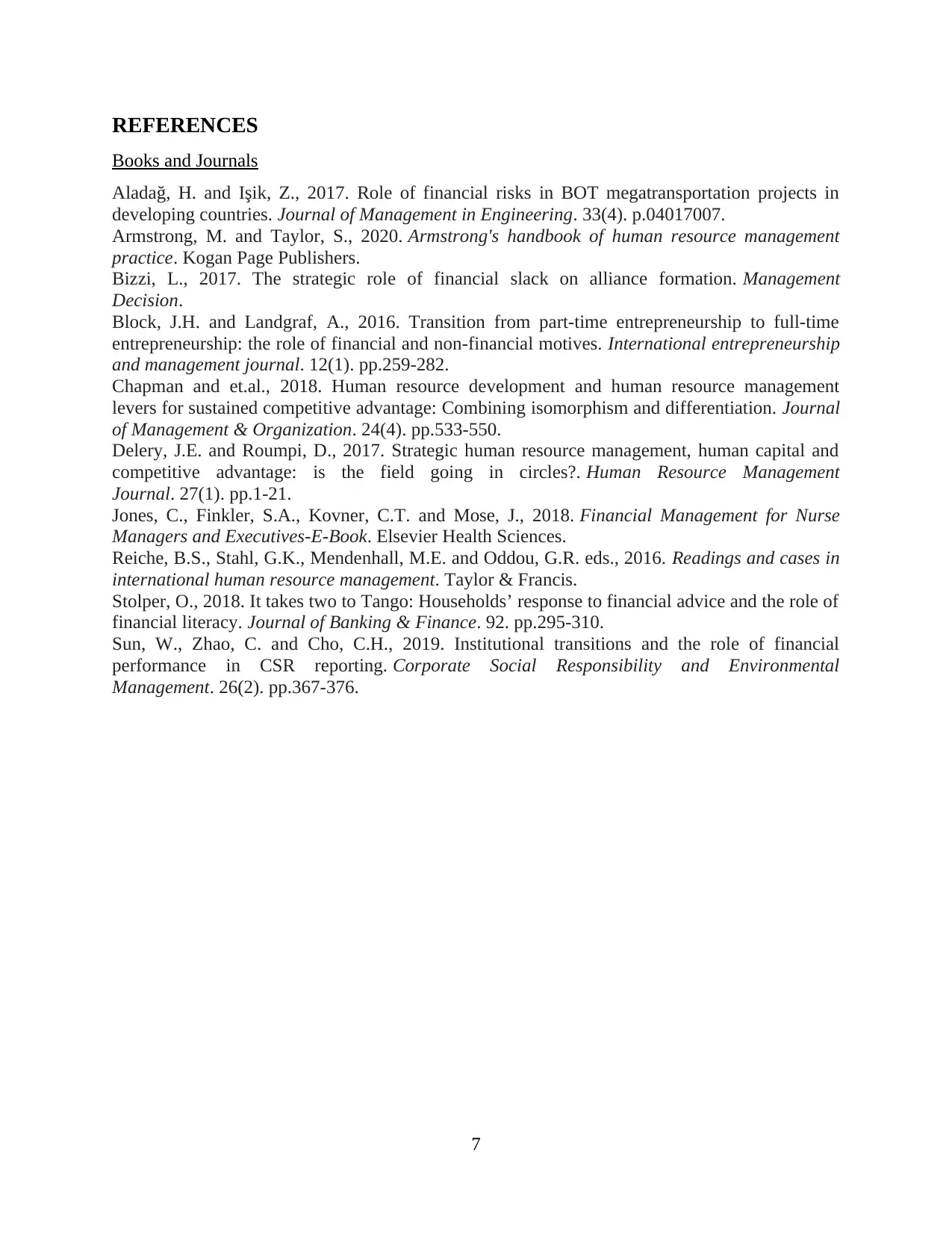
REFERENCES
Books and Journals
Aladağ, H. and Işik, Z., 2017. Role of financial risks in BOT megatransportation projects in
developing countries. Journal of Management in Engineering. 33(4). p.04017007.
Armstrong, M. and Taylor, S., 2020. Armstrong's handbook of human resource management
practice. Kogan Page Publishers.
Bizzi, L., 2017. The strategic role of financial slack on alliance formation. Management
Decision.
Block, J.H. and Landgraf, A., 2016. Transition from part-time entrepreneurship to full-time
entrepreneurship: the role of financial and non-financial motives. International entrepreneurship
and management journal. 12(1). pp.259-282.
Chapman and et.al., 2018. Human resource development and human resource management
levers for sustained competitive advantage: Combining isomorphism and differentiation. Journal
of Management & Organization. 24(4). pp.533-550.
Delery, J.E. and Roumpi, D., 2017. Strategic human resource management, human capital and
competitive advantage: is the field going in circles?. Human Resource Management
Journal. 27(1). pp.1-21.
Jones, C., Finkler, S.A., Kovner, C.T. and Mose, J., 2018. Financial Management for Nurse
Managers and Executives-E-Book. Elsevier Health Sciences.
Reiche, B.S., Stahl, G.K., Mendenhall, M.E. and Oddou, G.R. eds., 2016. Readings and cases in
international human resource management. Taylor & Francis.
Stolper, O., 2018. It takes two to Tango: Households’ response to financial advice and the role of
financial literacy. Journal of Banking & Finance. 92. pp.295-310.
Sun, W., Zhao, C. and Cho, C.H., 2019. Institutional transitions and the role of financial
performance in CSR reporting. Corporate Social Responsibility and Environmental
Management. 26(2). pp.367-376.
7
Books and Journals
Aladağ, H. and Işik, Z., 2017. Role of financial risks in BOT megatransportation projects in
developing countries. Journal of Management in Engineering. 33(4). p.04017007.
Armstrong, M. and Taylor, S., 2020. Armstrong's handbook of human resource management
practice. Kogan Page Publishers.
Bizzi, L., 2017. The strategic role of financial slack on alliance formation. Management
Decision.
Block, J.H. and Landgraf, A., 2016. Transition from part-time entrepreneurship to full-time
entrepreneurship: the role of financial and non-financial motives. International entrepreneurship
and management journal. 12(1). pp.259-282.
Chapman and et.al., 2018. Human resource development and human resource management
levers for sustained competitive advantage: Combining isomorphism and differentiation. Journal
of Management & Organization. 24(4). pp.533-550.
Delery, J.E. and Roumpi, D., 2017. Strategic human resource management, human capital and
competitive advantage: is the field going in circles?. Human Resource Management
Journal. 27(1). pp.1-21.
Jones, C., Finkler, S.A., Kovner, C.T. and Mose, J., 2018. Financial Management for Nurse
Managers and Executives-E-Book. Elsevier Health Sciences.
Reiche, B.S., Stahl, G.K., Mendenhall, M.E. and Oddou, G.R. eds., 2016. Readings and cases in
international human resource management. Taylor & Francis.
Stolper, O., 2018. It takes two to Tango: Households’ response to financial advice and the role of
financial literacy. Journal of Banking & Finance. 92. pp.295-310.
Sun, W., Zhao, C. and Cho, C.H., 2019. Institutional transitions and the role of financial
performance in CSR reporting. Corporate Social Responsibility and Environmental
Management. 26(2). pp.367-376.
7
⊘ This is a preview!⊘
Do you want full access?
Subscribe today to unlock all pages.

Trusted by 1+ million students worldwide
1 out of 9
Related Documents
Your All-in-One AI-Powered Toolkit for Academic Success.
+13062052269
info@desklib.com
Available 24*7 on WhatsApp / Email
![[object Object]](/_next/static/media/star-bottom.7253800d.svg)
Unlock your academic potential
Copyright © 2020–2025 A2Z Services. All Rights Reserved. Developed and managed by ZUCOL.




